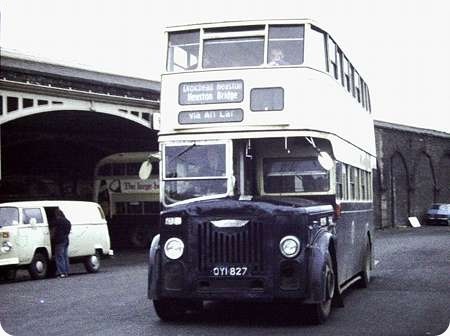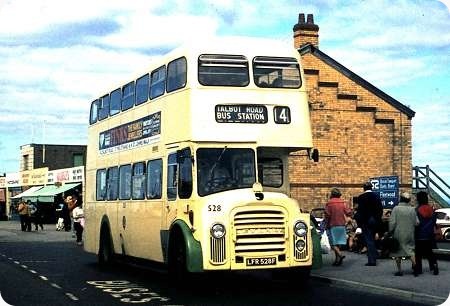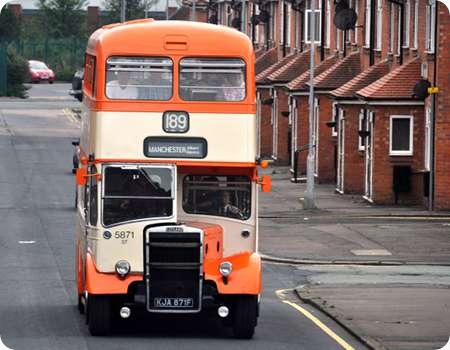
Copyright Brendan Smith
CIE (Coras Iompair Eirann)
1959/60
Leyland Titan PD3/2
CIE H41/33R
Seen in the dark blue and cream livery introduced for double-deckers in 1961, RA62 shows the final version of the CIE double-deck body, which is said to have been originally influenced by the prewar Leyland bodies supplied to Dublin United Tramways. The body design certainly had character, but was beginning to look dated by 1959, with its six-and-a-half bay construction, and Thomas Tilling-style three window arrangement at the front of the upper deck. Originally, the RAs were fitted with one-piece destination displays, but on overhaul the class later received the three aperture layout modelled here by RA62. The Titan PD3/2 chassis had semi-automatic transmission – and air brakes, whose fading characteristics have been so well described elsewhere on this website. Maybe the CIE versions had a holy statue in the cab as a back up system in case of emergency. Even then, the statue would probably have covered its eyes with its hands….
Photograph and Copy contributed by Brendan Smith
17/04/13 – 07:24
The "pseudo Birmingham" livery. Very nice!
Pete Davies
18/04/13 – 07:34
It has hitherto been my understanding that CIE double-deckers from this period had a position on the gear selector for fully automatic operation – or, at least, the ones used on Dublin City Services did, if that made a difference. Although the buses could theoretically be driven in semi or fully automatic mode, there was apparently a notice in the cab to the effect that drivers found selecting the gears manually (i.e. ‘semi’) would be dismissed.
This information came from a driver I once knew who had worked for CIE in Dublin.
Is it correct, do you know?
David Call
18/04/13 – 08:19
What an interesting question about the transmission! When I first moved to Southampton in 1970, I was working with a fellow who was in his last few months of work before retiring. He had a "mid 60’s" car which had the usual three pedals, but he hardly ever used the clutch, saying that his car had this same arrangement as David reports. He’d slip the car into that gear and move off. It was a Wolseley of some sort, if I remember correctly.
Pete Davies
18/04/13 – 16:51
I wonder what the reasoning for that gear selection instruction was….During my time on London Transport (1975-1978 at New Cross and Walworth) I only ever drove manually in spite of the RMs, RMLs and DMSs having the same gear selection arrangement. I found that I could drive the buses more smoothly in manual, and it was useful when driving up steep hills with a full load of passengers (like Shooters Hill) to be able to keep the bus in the correct gear until the gradient lessened.
Norman Long
18/04/13 – 17:41
Not quite the same, Norman, because the vehicles were then becoming quite elderly, but the instruction – when I drove for Reading Mainline – was always to drive in semi-automatic mode.
David Oldfield
19/04/13 – 06:49
Wolseley, Pete… Didn’t the big ADO minis & even the originals have a sort of semi automatic box where you could choose to change or just drive… or am I imagining that…. very clunky & jerky… with a crude straight gate and change…?
Joe
20/04/13 – 11:47
Joe, I think the car my colleague had was getting on for the size of something like the Austin Princess, but not quite as big, certainly not one of the Mini, 1100, 1800 family.
Pete Davies
20/04/13 – 17:11
The 1800 "Land Crab" was a deceptively spacious car, predecessor to the atrocious Princess: like the Princess it had a 6 cylinder option but the Princess had a standard automatic box. The Wolseley versions had Wolseley names like 18/85.
Some of this generation did have a semi auto box, though, but I think only the Mini and 1100- so it could have been a Wolseley 1300? These cars seemed big!
Googling seems to confirm.
Joe
20/04/13 – 17:13
A Wolseley 6 maybe?
Stephen Ford
20/04/13 – 18:18
Atrocious is the perfect description of the Princess – a company I worked for foisted one on me which I refused to use and was very happy to have exchanged for a second hand Cortina. BL gave the Princess a sex change and brought out the Ambassador, just as bad and equally loathed.
The 1100 and 1300 were a breed apart from their larger outgrowths which were, the original 1800 apart, appalling.
Phil Blinkhorn
21/04/13 – 08:01
Sorry, Joe. I can’t have expressed it properly. The Princess I had in mind was not the item which I have seen described as a sewage farm on wheels. From looking at Wikipedia, my guess is that my colleague’s beast was the Westminster, with Wolseley badges.
Pete Davies
21/04/13 – 09:56
Consensus has it that the 1100/1300 and "land-crab" 1800/2200 were essentially good cars – if a little bit underfunded on R & D or quality. One disgraceful aspect of English manufacturers at that time – especially BMC and Rootes – was badge engineering, but they also recycled model names. The Austin Princess was an honourable name by a fine (traditional) manufacturer. [Again, don’t confuse the real Austin/Morris et al with their shadowy and shady British Leyland personas.] The BLMC Princess was not the same beast.
David Oldfield
21/04/13 – 11:12
In 1966 when I was 19 I was employed as a management trainee for a major UK company. One of our jobs was to "sub" for area reps if they were ill or on holiday. Our South London, Kent and Sussex rep had a stay in hospital and I was sent from Manchester to sub for him. I travelled in my upright Ford Popular which I expected to use for the duration of my stay and did for the first few weeks.
When the rep came out of hospital he had a six week convalescence and during the last two weeks he came around with me instead of "being bored at home". He couldn’t drive until signed off but gave me the keys to his car. Our reps could have a company car or use their own which was covered by the company insurance. For two weeks I had the great pleasure of driving a 4 litre Princess R around the South East. Vanden Plas body, Rolls Royce engine and BMC engineering at its best!
Phil Blinkhorn
22/04/13 – 07:53
A coach operator friend of mine in Sheffield also ran private hire taxis and wedding cars for a while. [He "did" one of my brothers’ wedding.] He had a RR Princess 4 litre. Apparently the engine was never used in a RR car – it was derived from an engine used by the Army in an armoured car! My driving instructor had the predecessor 3 litre Princess as his private transport.
David Oldfield
22/04/13 – 10:16
We had a complaint a year or two back from someone who thought we got off the point too much. Much as I have enjoyed this thread, and joined in, I think that we probably are naughty little boys and have strayed a little far off the appointed track. [I don’t recollect ever seeing a half-cab Austin Princess or one bearing an "O" licence.]
David Oldfield
22/04/13 – 10:16
The FB60 engine was a smaller version of the RR Military B. The Princess R was the only civilian vehicle mass produced by another manufacturer using a Rolls Royce engine.
Phil Blinkhorn
22/04/13 – 14:35
David, whilst I fully understand your point, one of the joys of this site is the way we can wander down memory lane, taking the odd side path which leads who knows where. Of course being well experienced in finding our way around we all eventually seem to get back on track!
Phil Blinkhorn
22/04/13 – 18:24
So, as we were saying, AP made a semi automatic box for small cars (Mini, 1100) in the style of these bus transmissions. Why, though, were CIE drivers (allegedly) fired for using it? It seemed to be the norm on rear engined buses in those days. I would have thought the power available on a bus of this age would demand some intervention… any drivers know?
Joe
23/04/13 – 07:57
Didn’t Northern Scottish use an Austin Princess licensed as a PSV on an airport service? I think it was an E-suffix registered car, so would have been new in 1967. Of course it wasn’t a half-cab, and nor was it in Northern Scottish yellow/cream livery – but standard black I think. Memory says it was even numbered "NX1". So if my memories are correct, there is a link between the meanderings on this topic!
Michael Hampton
23/04/13 – 07:58
Interesting comments relating to fully-automatic ‘boxes with semi-automatic over-ride. It’s fascinating how operators seem to have had such differing views on how they should be used. From observances riding on LT Routemasters over the years, their drivers in the main seemed to prefer controlling the gear selection themselves. On the few occasions where the transmission had been seen to be left to its own devices, the progress seemed more stately. One thing still intrigues me though. Drivers of semi-automatic vehicles were usually instructed to pause in neutral when changing up, in order to let the engine revs drop and effect a smooth change. This also prolonged gearbox brakeband life. Semi-auto gearchanges carried out under power were frowned upon by engineering staff, yet the Routemaster, with a broadly similar transmission, actually operated like this in fully-automatic mode. Can anybody work it out?
Meandering back off piste, didn’t the Austin Champ (a would-be challenger to the Land Rover) also have a Rolls-Royce engine? Going a little further off piste, Wolseley versions of the Austin Westminster were the 6/99 and later 6/110. They sported that delightful Wolseley feature – the illuminated radiator badge. A lovely touch on a decidedly handsome car. Today, no doubt this would be ‘cool’. We simply called it class.
Brendan Smith
23/04/13 – 07:58
Phil. My friends will also tell you of my ability to stir it!
David Oldfield
23/04/13 – 13:56
The Austin Champ was designed to reduce UK military reliance on US built Jeeps but it was eclipsed by the Land Rover. Initial production models had Rolls Royce built engines but most vehicles had a modified version built by BMC under licence. The relatively few vehicles built for the civilian market had the licenced built engine as an option but the majority had an all BMC engine.
David, I bet my stirring spoon is bigger than yours.
Phil Blinkhorn




